|
|
|
|
|
|
|
|
|
On this page:
|
Collaborative Virtual Reality
|
|
|
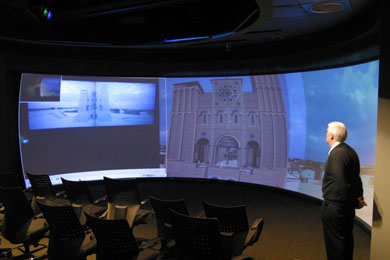
ATS has been working with Iowa State
University’s Virtual Reality Applications Center to develop the
innovative techniques and build the infrastructure to share
virtual reality models across the Internet.
This technique – called Collaborative VR – was added into the vrNav software, which is normally used to
fly through virtual world models in the Portal. Collaborative VR
was demonstrated in April between the
Portal and Iowa State’s Human Computer Interaction Center.
Here’s how it works. With Collaborative VR now built into vrNav,
vrNav is started up on the same model in two different facilities.
As the people at one location fly through the model, the vrNav
they are using controls the vrNav at the other facility so that it
flys identically. The audiances at both locations see the same
view of the model simultaneously.
At the same time that people at UCLA were modifying vrNav,
research at Iowa’s VRAC were modifying
vrJuggler for collaborative use. One of their innovations was to
add an avatar to the scene. The avatar, which marks the location
of the viewer in the model, is controlled by one side and moves
identically through the models at both locations.
Research Scholar Chris Johanson and Visualization Portal
Development Coordinator Joan Slottow led the
UCLA team to build in rudimentary Collaborative VR into vrNav.
Learn more about vrNav at:
/at/vrNav/default.htm).
For the April demonstration, Professor John Dagenais, UCLA Spanish
and Portuguese Department was in the
UCLA Portal as he gave a virtual tour of the Santiago de
Compostela model to the audience at Iowa
State. The second successful demonstration of Collaborative VR was
made the following day between UCLA
and the University of Mexico.
The long-term benefit of Collaborative VR, is that it will allow
an expert in one geographic location to
fly through computer simulated models in real-time at two
locations as he delivers lectures to a remote
audience.
Back to top
|
|
Learn about vrNav:
/at/vrNav/default.htm |
Future Scholars
|
|
|
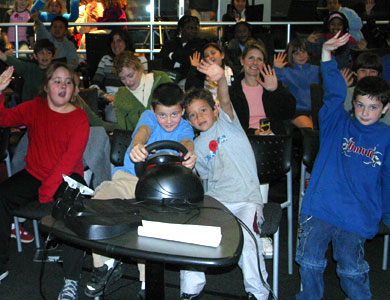
Roosevelt School third graders take a turn at
the Visualization Portal steering wheel to fly through a virtual
reality model of UCLA. Virtual UCLA was created by the Urban
Simulation Team. More than 1,800 students representing 50 K-12
schools have visited the Portal since it opened in 2001.
Back to top
|
|
|
Computation-based Research at ATS
|
|
|
|
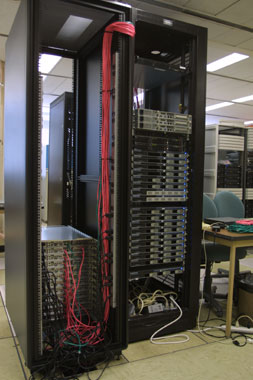
Academic Technology Services has
implemented a program for hosting computational clusters in the newly
renovated research data center. The core idea is to preserve researcher
ownership and on-demand access to the resource while making available data
center space and, and in some cases, cluster administration.
ATS will offer tiered levels of service. Tier 1 provides space,
enviromentals, and security for researchers who plan to administer their own
cluster. Tier 2 continues ATS’ existing cluster consulting program for
researchers who want to locate their cluster in their own space but need
support in its configuration. Tier 3 (full service) provides Tier 1 service
levels with the addition of ATS system administration, storage and archival
services.
ATS has established a long-range goal of eventually supporting a total of
1,200 nodes and is currently identifying the required infrastructure to
support such a resource.
ATS is already involved in two
cluster-hosting arrangements.
Plasma Physics Cluster:
Academic Technology Services has submitted a RFP on behalf of the Plasma
Physics group for a 256-node, 512-processor computer cluster to advance
research and education in broad and diverse areas of plasma science. Vendor
selection is expected to conclude in this month. The cluster will be built
using a $1 million National Science Foundation Major Research
Instrumentation (MRI) grant to UCLA Physics faculty. The cluster will be
housed in the UCLA research data center.
California NanoSystems Institute (CNSI)
Cluster: The CNSI Computational Committee is now
in the process of upgrading their HP cluster. ATS - through the Technology
Sandbox - will conduct benchmarking on 3 HP products: a new dual-Xeon node,
the fastest Itanium 2 node, and a mid-range Itanium 2 node. ATS will also be
investigating a new switch that will allow CNSI to upgrade to a total of 50
to 60 nodes and plans to add an HP backup system with this upgrade.
For information on cluster hosting at
Academic Technology Services, contact Bill Labate at:
labate@ats.ucla.edu or 310-206-7323.
Back to top
|
|
|
Student Advances to Professor Faster Using
Portal Resources
|
|
|
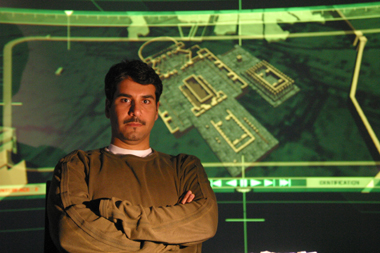
Abdul-muttaleb al-Ballam earned his Ph.D. in architecture and is embarking
on a career as a university professor a little more quickly than he might
have, thanks at least in part to UCLA’s Visualization Portal and Modeling
Lab. al-Ballam is one of six people who have used the Visulization Portal to
work on or defend their dissertations.
“With the facilities at ATS, I was able to finish my dissertation in one
year,” al-Ballam said. “This would have taken me three years in a different
place.”
Al-Ballam, who came from Kuwait to study at UCLA, had been doing his
computer-aided design work at another digital facility on campus when a
fellow student introduced him to the high-speed world of ATS.
“The Modeling and Visualization Lab is what impressed me because they had
many types of software that I needed in order to accomplish my
dissertation,” al-Ballam said. “I could build my 3-D urban models in Creator
and transform them into VRML Code. That’s a 3-D representation language for
the Web. From there, I could take the code and manually change it and
enhance it.
“With the availability of fast PCs equipped with very fast video cards,
which enable you to run the real-time animation, I was able to shorten the
project time,” al-Ballam said.
For his doctoral dissertation, al-Ballam developed a digital teaching tool
that he hopes will help college architecture students better understand how
an urban environment evolves through the ages. It focuses on the Lebanese
city of Baalbek and was designed to be viewed in real time over the
Internet. It allows students to “fly” through the streets of the ancient
city, studying the influence of the numerous cultures that settled there
over a span of 13 centuries. “It gives a good idea of how certain urban
evolution has happened,” al-Ballam said. “As a student moves through the
model, he will witness the buildings change with time. It’s a virtual time
machine.”
Al-Ballam, who holds a master’s degree and bachelor’s degree in
architecture, explained the importance of understanding how different
cultural influences on urban development are related. “When a historian
interprets history without an overall view of the connection between
cultures, then he has a problem. He doesn’t see how the city evolved
continuously. With my tool, he’ll be able to see this continuous evolution
and he’ll have less of a chance to be biased against certain cultures.”
As his model was developing, al-Ballam would invite his professors and
advisers to Portal for viewing and critique sessions. He also used the
Portal for the successful defense of his dissertation before his doctoral
committee. “The setting of the portal is very professional,” he said. “It
has elevated my project. There is no other place on campus where you could
find a wide-screen projector. Seeing my project there helped my committee
‘live’ the model.”
With his new Ph.D. degree in hand, al-Ballam is returning to his homeland
where a teaching position awaits him at Kuwait University. He said his time
in the Modeling and Visualization Lab and in the Visualization Portal has
inspired him to work to reproduce the same kind of facilities at home.
Back to top
|
|
|
Dancing in Digital Space
|
|
|
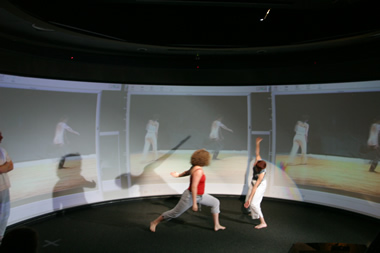 Dancer Norah Zuniga Shaw, Department of World Arts and
Cultures, used the Visualization Portal to teach an undergraduate
course that examined the relationship between emerging technology
and the arts. Shaw and her students linked up with their
counterparts at the University of Riverside to develop movement
and media improvisations that bring together live dancing bodies,
virtual reality models, streaming media and
OpenMash videoconferencing technologies.
Read the course proposal.
See more photos.
For more information see:
www.zunigashaw.com.
Back to top
|
|
|
|
|
|
|
|
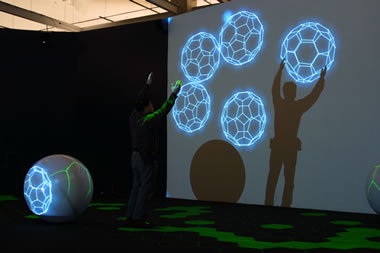
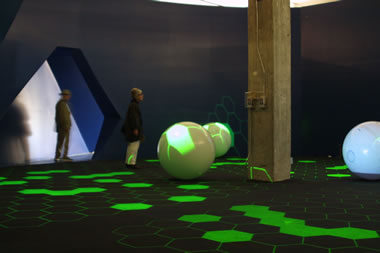
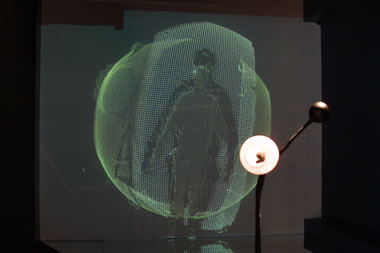
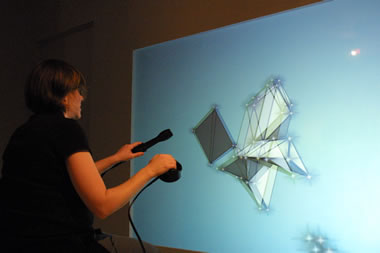
In Victoria Vesna's world, science is artistic and art is scientific. Vesna is a media artist,
and she defines her art as "experimental research." A professor at UCLA's
School of the Arts and
Architecture, she is chair of the school’s
Department of Design | Media Arts and is a renowned
master of her genre. A media artist, Vesna explains, is "someone who works with technology and
collaborates with many different disciplines, looking at contemporary issues that are raised by
scientific and technological innovations."
In her field, the computer is not a tool - it is a medium, like oil colors or a piece of clay.
And her creations aren't merely physical – something on display in a gallery or museum.
They also exist in the virtual world of the Internet.
"My goal is to show that these worlds have a distinct quality in relation to time and navigation
but are not separate, and one is not more important than the other," she said.
Vesna's primary world is art, but in the past decade, her interests and curiosities increasingly
have crossed into the realms of science and technology.
She says she finds "science labs much more fascinating then artist studios." As a result, her numerous
collaborations with scientists should come as no surprise. In particular, she has been teaming up with
those working at the atomic and molecular levels in the field known as nano technology.
One of her more recent works, titled, "zero@wavefunction: nano dreams & nightmares," was created in
collaboration with noted UCLA nano scientist James Gimzewski in tribute to her fascination with hexagons and
their role in nature. The work incorporates virtual buckyballs – the nickname given to a hollow, sphere-shaped
carbon molecule reminiscent of architect R. Buckminster Fuller's geodesic dome.
Zero@wavefunction is meant to simulate the way a nano scientist manipulates an individual molecule – projected
on a monumental scale. Software authored by then-UCLA Design | Media Arts student Josh Nimoy allows a
viewer – both in person, looking at a giant screen, and via the Internet – to manipulate the buckyballs by
activating a series of visualizations, sounds and texts.
The work has become a permanent installation at the Visualization Portal. Academic Technology Services
was instrumental in the work's creation. "Without their help, this piece simply would not have been achieved in
time to premiere at the Biennial of Electronic Arts in Perth, Australia, in August 2002," Vesna said.
Vesna also worked with ATS staff as well as Design | Media Arts students when she redesigned the
entire California NanoSystems Institute Web site, which, like her artwork, is interactive, allowing
viewers to change images as they wish.
Zero@wavefunction is at the core of a new work commissioned by LACMALab. nano opened this month at the
Los Angeles County Museum of Art and will be on exhibit through September 2004. Once again, Vesna has partnered
with nano scientist Jim Gimzewski to create what she calls a "groundbreaking exhibition that will immerse visitors
of all ages in a visceral, multimedia experience of the convergence of computing, nano science and molecular biology."
Vesna says visitors to "nano" interact with multimedia representations of atomic- and molecular-scaled
structures. They experience the exhibit through their eyes, ears, hands, "even through their feet as they wander
over a reactive floor that mimics the structure of graphite," she said.
The UCLA Technology Sandbox – a place where innovation and collaboration are encouraged - provided Vesna and
her team with a testing ground for various elements of nano. "The ATS Sandbox's support has proved to be
critical in the production of these new works," Vesna said. "These projects are viewed by the public
at large and support the creative work of UCLA artists, scientists and humanists who work collaboratively to
promote new ways of thinking and being in the ever more complex world we occupy."
Back to top
|
|
|
|
|
|
|
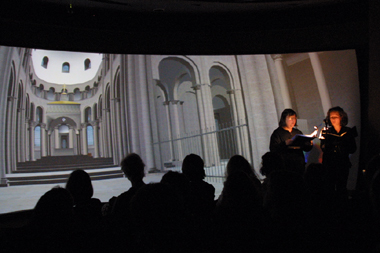
Portal visitors made a virtual pilgrimage to 13th century Spain to visit
Santiago de Compostela this month during a two-day history and virtual reality conference
hosted by Professor John Dagenais, Spanish and Portuguese Department. Highlight of the
conference was a concert by the Medieval singing group, UCLA Sounds, held in the virtual
cathedral. This was one of the first truly "mixed" virtual reality performances, where
live performers were placed acoustically in a virtual model of the medieval cathedral
Santiago de Compostela.
Read the story of Santiago de Compostela.
Read about the innovative sound server that made the concert possible.
Concert in the Cathedral Program
Back to top
|
|
|
|
|
|
|
|
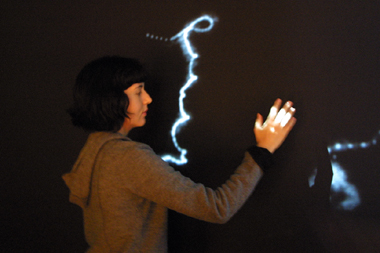
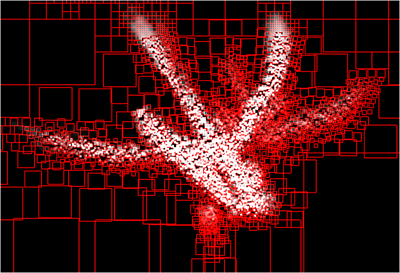
Ecce Homology Exhibit Merges Art and
Science
Imagine a work of art that provides an
individual viewer the opportunity to become part of a complex science
experiment at the same time that it offers beauty and a meditative moment.
Ecce Homology – a 60-foot-long,
12-foot-high interactive art installation that uses a variety of innovative
computer technologies is such a work, and it’s set to open as part of the
Fowler Museum’s “From the Verandah” exhibit on Nov. 6.
Several projects at UCLA in the past
two years have been aimed at tying art and science in a way that will draw
in lay audiences and allow them to become acquainted with sciences that
include genomics, proteomics, and nanotechnologies. Ecce Homology –
the latest of such art-science blends, is an artistic exploration of the
human and rice genomes.
At the Fowler exhibit, visitors will
become part of a huge projection in which they can discover evolutionary
relationships between human genes and those from a rice seedling. A custom
computer vision system will track each visitor’s movements and create
light-filled traces into the actual projection. This will allow the visitor
to interact with luminous pictographic projections – visualizations of
actual DNA and protein information – as the viewer stands in front of the
projection surface.
Each pictogram represents either a
human gene or a gene from the rice genome that is part of metabolic pathway
for the process by which starch is broken down into carbon dioxide. The
pictograms are both scientifically accurate visualizations and metaphors for
the cycling of energy and the unity of life.
Each viewer – by placing his body into
the projection area and moving slowly, performs a scientific experiment that
looks for evolutionary relationships between the human and rice genomes.
This artistic experiment is the same experiment conducted by researchers
participating in the world-wide genome sequencing projects that is done via
web-based servers and interfaces using a tool called “BLAST.”
BLAST (Basic Local Alignment Sequence
Tool) is the method to access what is currently known in genomic biology.
Almost every life science-related research laboratory in the world uses
BLAST, making it the most widely used data-mining tool in history. The
national Center for Biotechnology Information receives more than 100,000
BLAST searches daily. Despite its ubiquity, for most researchers BLAST is
an unseen process.
Ecce Homology is an artistic
representation of the BLAST process. While participating in the art
installation, each visitor initiates the BLAST operation to generate
automated comparisons of the human and rice genomes, which are shown through
changes in the pictograms.
Ecce Homology was created by in
silico v1.0 – a group of UCLA artists and researchers whose work bridges
art and science through the use of dynamic media. Ruth West, an artist and
molecular genetics researcher is leader of in silico v.1.0.
Ecce Homology is the result of a creative collaboration between artists and
scientists Ruth West, Jeff Burke, Cheryl Kerfeld, Eitan Mendelowitz, Tom
Holton, JP Lewis, Ethan Drucker, Weihong Yan.
The project is being supported by
several academic and commercial organizations, including UCLA’s Technology
Sandbox, Academic Technology Services, Intel Corporation, NEC Corporation,
the UC San Diego Center for Research in Computing and the Arts, and the
Computer Graphics and Immersive Technology Laboratory, USC Integrated Media
Systems Group.
For more information, visit:
http://www.insilicov1.org
www.fowler.ucla.edu
www.ats.ucla.edu.
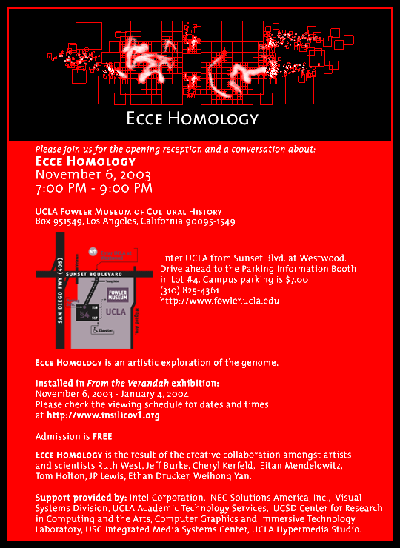
Back to top |
|
Multimedia Links:
See the Ecce Homology video:
|
Disabilities and Computing Program Open House
|
|
|
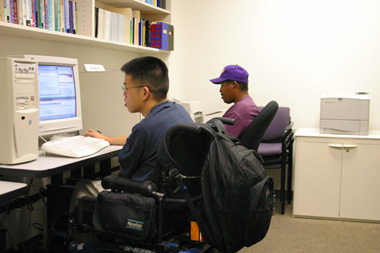
Patrick Burke and John Pedersen in the
Disabilities and Computing lab on Wednesday, Oct. 29 show off
the latest adaptive computing
technologies available. Demonstrations of state-of-the-art
technologies in screen-reading, magnification, voice recognition, scanning
and reading and study software.
For more information about the Disabilities and Computing program,
see: www.dcp.ucla.edu
Back to top
|
|
Multimedia Links: |
|
|
|
|
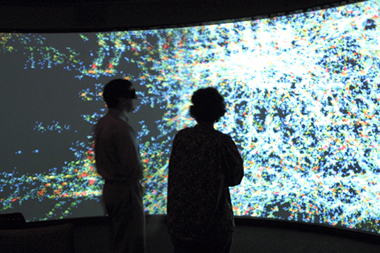
The Universe
Studying the birth of the universe has
traditionally been a matter of theory, prediction, speculation, and more
recently, computer simulation. But today, astronomers such as UCLA’s Matt
Malkan are able to look deep into the sky and observe the real thing as it
appeared billions of years ago. Highly advanced telescopes, such as the
Hubble Space Telescope and the Keck in Hawaii, have dramatically changed the
field of astronomy. Thanks to these telescopes, Malkan and others can view
the infancy of very distant galaxies – back when their stars had just begun
to throw off detectable light.
And, thanks to UCLA’s Visualization
Portal, Malkan and other UCLA researchers are able to bring their work to
students, other researchers and broader audiences.
“The Portal allows us to look pretty
closely at these rather horrendously complex simulations. A supercomputer
can simulate literally millions of points in a volume of space, more than
most humans can comprehend.” The Portal offers a 3-dimensional moving
display of a computer simulation, making it easier for the human mind to
grasp.
“We’re using telescopes as time machines
so we can look back in the early days of the universe and see what these
young galaxies are doing,” Malkan said. “It takes the light rays that we’re
detecting more than 10 billion years to travel from where they started –
from when they were produced – and they leave their galaxies carrying a lot
of interesting information.”
The hope is that by studying these
faraway galaxies in their formative stages, astronomers will be able to
update scientific theory and prediction to answer lingering questions about
the structure of the universe and the evolution of our own galaxy - the
Milky Way.
Malkan’s work focuses on the photons –
or light particles – that infant galaxies produce, especially when a star is
created. Once the photons are collected on the Keck’s or the Hubble’s giant
mirror, Malkan works to determine how long they’ve existed and how far back
in the history of the universe he is peering. He’s able to make these
measurements by comparing the size of the universe when the light rays first
began their journey through space to the current size of our ever-expanding
universe. A relatively new calibration of the universe’s expansion has made
it possible for astronomers to put a fairly accurate time stamp on each of
the galaxies under observation. Malkan is working
closely with University of Zurich physics theorist Ben Moore, a proponent of
the “dark matter” theory of galaxy formation.
“The Portal is unique in letting us look
at these millions of points in space simultaneously,” Malkan said. “We can
watch the universe move forward or backward in time and see how it’s
changing before our eyes.” He also is able to move around inside the
simulated universe and see how it looks from different locations.
As a teaching tool, the Portal is
incomparable, Malkan added. “Watch this model in the Portal for five
minutes and you will understand better how our universe formed its
structure,” Malkan said.
|
|
Multimedia Links: OuickTime
Movie of the Universe:
|
|
Back to top |
|
|
|
|
|
|
|
|
|
|
|
|
|
|
|
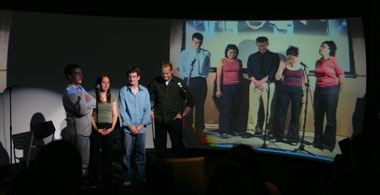
UCLA performers in the foreground and Stanford
performers on Portal screen in the background.
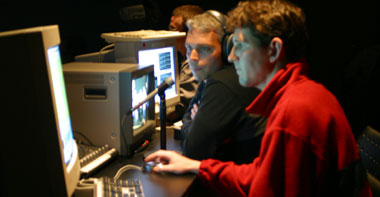
Faculty Advisor David Beaudry (left) and student Alex Hoff.
A distributed, improvisational performance was
presented in the Visualization Portal earlier this month as an
Advanced Sound Design class project. Visiting Assistant Professor
David Beaudry, UCLA Department of Theater and Consulting Professor
Elizabeth Cohen, Information Studies, were faculty advisors on the
project which was designed to explore the possibilities and
challenges of creating a theatrical performance that occurs
simultaneously in two geographical locations. The performance
featured two groups of theatrical improvisers - one group at
Stanford’s Wallenberg Hall and the other at UCLA's Visualization
Portal.
The UCLA-Stanford Distributed Performance Project - created by
Visiting Assistant Professor David Beaudry, UCLA
Department of Theater, Consulting Professor Elizabeth Cohen,
Information Studies, and Stanford student Daniel
Walling - explored the possibilities and challenges of creating a
theatrical performance that occurs simultaneously in two
geographical locations. The performance featured two groups of
theatrical improvisers - one group at Stanford’s Wallenberg Hall
and the other at UCLA's Visualization Portal. A group of theater
sound design students from UCLA created immersive, multi-channel
environments and sound effects to support the improvisations. The
improvisational groups were connected by real-time audio and video
streams using the Internet2 backbone.
This project addressed several problems.
First, it attempted to overcome the geographical distance between
actors and designers during the performance.
Previous attempts to do this have fallen short due to network
latency issues that negatively impact the quality of sound and
video. Improving one was generally at the sacrifice of the other,
and therefore it was impossible to create a viable forum for
exchange. Recently, however, technological advances - particularly
in networking – allowed the project participants to create viable
virtual performance spaces: two physical locations joined by the
Internet to create a single, unique and fluid performance
environment.
The second goal was to address the problem of theatrical sound
design for both an improvised performance and a
networked performance. In traditional theater - where audiences
are located in a single location - sound designers build cues and
sound effects to support the action on stage. When building those
cues, designers usually have a script from which to design the
sound component and a predictable (i.e. linear) order of execution
during performance. The designers on this project were challenged
not only to create interesting and complex sound as a viable part
of an improvised performance, but they also had to design the
sound to be engaging in both geographical locations. This dual
challenge required a rethinking and restructuring of the
traditional methods used in theatrical sound design.
The third goal of this project was to effectively archive the
performance. How does one document and archive a
collaborative theatrical performance when the performance bodies
are in physically distinct locations and the collaborative
environment is virtual? How does one handle the archiving of eight
channels of audio, two video streams, nine actors, and two
audiences that were involved in this production? Documenting such
an event - not
just the performance but the process as well - was a formidable
challenge.
Project Goals
• To enable spatially distributed improvisational performance.
• To identify the technology that enables spatially distributed
performance.
• To understand what contributes to the perception of “ensemble.”
• To create a robust digital archive of the performance.
• To address the problem of theatrical sound design in entirely
improvised performances, as well as
network-based performances.
Several important components comprised this performance project.
Audio and Video Streaming
The audio connection is supported by the StreamBD software -
created by the SoundWIRE research group at Stanford’s CCRMA
- streaming uncompressed, multi-channel, professional-quality
audio over Internet2. StreamBD
is research-prototype software that provides low-latency
uncompressed audio streaming over high quality networks. It was
created to run on "CCRMAlized" computers running Linux/OSX. The
delays in streaming are only a few milliseconds above latency.
The project uses OpenMash for video streaming. OpenMash allows for
high-quality video streaming approximately
150 milliseconds above network latency. The project also uses
RTPtv, an open-source software package that runs
on Linux and Windows to send and receive high-bitrate "broadcast
quality" television - stereo audio and either
720x480 or 720x576 interlaced video (D1 video) or 352x240 or
352x288 progressive video (CIF) - over IP using
the IETF RTP protocol and M-JPEG (Motion JPEG).
Sound Design
The sound designers built custom software and interfaces for
real-time control and processing of both live and
prerecorded sound. The software uses IRCAM/Cycling74’s multimedia
programming environment, Max/MSP.
Faculty Advisors
David Beaudry, Visiting Assistant Professor, UCLA Department of
Theater Virtual Reality Audio Specialist & Audio Technologist,
UCLA Visualization Portal/Academic Technology Services
Elizabeth Cohen, Consulting Professor, Electrical Engineering,
Stanford University and Visiting Professor of Information Studies,
UCLA
Chris Chafe, Professor of Music, Stanford University, Director
CCRMA
People Involved
Actors - All of the performers are current members or alumni of
the Stanford Improvisers (SImps), coached by
Patricia Ryan.
Sound designers - Both sound designers were students in David
Beaudry’s Advanced Theater Sound Design class.
Archivists - All archivists were students in Elizabeth Cohen’s
class.
Coordinators:
UCLA – David Beaudry, Visiting Asst. Professor in Sound Design,
UCLA Dept. of Theater, and Virtual Reality
Audio Specialist, UCLA Visualization Portal.
Stanford University – Daniel Walling, Stanford University.
|
|
Multimedia Links: Video clips
of the performance:
This video clip shows a scene about a child and her
grandfather on a fishing trip. Actors from UCLA and Stanford simultaneously
act out the same scene. The catch is that the actors from each place take
turns making up dialog and acting out a story as the actors from the other
venue imitate them. On the clip you’ll see the UCLA performers in the
foreground and the Stanford actors on the Portal screen in the background.
|
|
Back to top |
|
|
|
|
|
|
|
|
|
|
|
|
|
|
|
zero@wavefunction: nano dreams and nightmares, a unique UCLA
Media Art/NanoScience collaboration was recently unveiled to a campus
audience at the Visualization Portal.

Created by Victoria Vesna, chair of
the Department of Design/Media Arts and James Gimzewski, a leading expert on
nanotechnology and a professor in UCLA’s Department of Chemistry and
Biochemistry, zero@wavefunction was conceived to help make nanoscience more
accessible and understandable to the broader public.
Buckyballs (shown in the photo) respond via sensors to
movement of a person’s shadow.
See a movie of buckyballs:
Quicktime
(high bandwidth) /
Quicktime
(low bandwidth)
For more information, go to:
http://notime.arts.ucla.edu/zerowave
|
|
Multimedia Links: OuickTime
Movie of Buckyballs
|
|
Back to top |
|
|
|
|
|
|
|
|
|
|
|
|
|
|
|
Medical Students viewed a live orthopedic
surgery from the Visualization Portal as part of an
Internet2 member meeting hosted by USC. While doctors in the
UCLA Medical Center explained the surgery and answered
questions, students were also linked to an orthopedic
surgeon at Stanford’s SUMMIT, who used a 3-D hand model to
further explain the surgery, and to orthopedic surgeons at
the conference site. Goal of the project was to explore
teaching opportunities provided by Internet2.
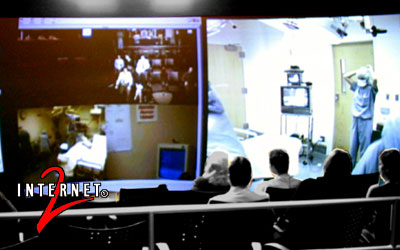 |
|
Multimedia Links:
|
|
|
|
|
|
Back to top |
|
|
|
|
|
|
|
|
|
|
|
|
|
|
|
A 3-D immersive
computer model of the Roman Forum at the peak of its development
just prior to the fall of the Roman Empire was unveiled to a prestigious
audience in the Visualization Portal in January. The audience
included Dr. Paolo Liverani, Curator of Antiquities for the
Vatican Museums and scholars from UCLA and other
universities. Dr. Bernard Frischer, director of UCLA’s
Cultural Virtual Reality Lab, Dean Abernathy, chief modeler
of the visualization, and Dr. Diane Favro, CVR Lab associate
director for research and development, talked about the
value of the model and the huge effort involved in creating
it. Believed to be the most complex
digital model ever created of an archaeological site, the model shows 22
buildings and monuments based on the latest research on the Forum.
Only two of the structures – both badly damaged – survive in Rome today.
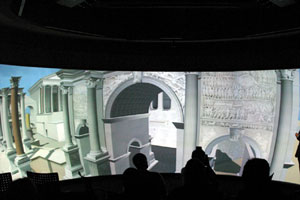
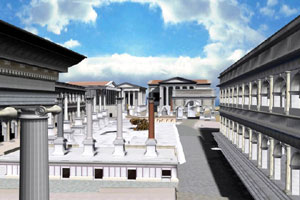 |
|
Multimedia Links:
|
|
Back to top |
|
|
|
|
|
|
|
|
|
|
|
|
|
|
|
Professor John Dagenais, Department of Spanish and
Portuguese, uses the Visualization Portal to show a model of
the Cathedral of Santiago de Compostela, the Romanesque
pilgrimage cathedral of the medieval period.
The digital model
recreates the medieval cathedral and allows students and researchers to
experience the space of the cathedral as it would have been seen by
medieval pilgrims to Santiago de Compostela.
The simulation serves
as the background for Professor Dagenais' introductory course in
Medieval Spanish literature and as an ongoing research project for
students in a summer-session class studying and traveling the pilgrimage
route. The model is also beginning to be used by architectural
historians and archeologists to pose questions about the development of
the building over time and as a way of testing various scenarios for
archeological reconstructions. This restoration project shows the
building as it appeared when dedicated by Bishop Pedro Munoz on April 3,
1211 A.D.
Dean Abernathy,
Architect, a principal member of the
Cultural VR Lab and a Ph.D. candidate at UCLA, was chief modeler
on the project.
Doing some additional research work in the ATS
Visualization Lab on the Cathedral Santiago de Compostela project:
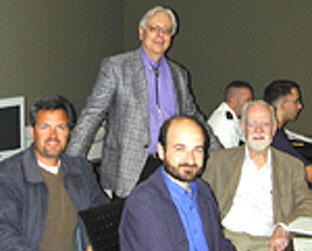
Dean Abernathy, UCLA Cultural VR Lab (left); Jose Suarez Otero, Archeologist and Conservator, Cathedral of
Santiago de Compostela (center); John Williams, Visiting Mellon Professor of the History of Art
and Architecture, University of Pittsburgh (right); John Dagenais, Professor of Spanish and Portuguese
(top).
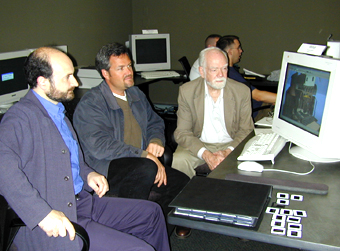
Jose Suarez Otero, Archeologist and Conservator, Cathedral of
Santiago de Compostela (left); Dean Abernathy, UCLA Cultural VR Lab
(center); John Williams, Visiting Mellon Professor of the History of Art
and Architecture, University of Pittsburgh (right) |
|
Multimedia Links:
|
|
|
|
|
|
Back to top |
|
|
|
|
|
|
|
|
|
|
|
|
|
|
|
Musical Arts Doctoral Candidate David Beaudry used the
unique capabilities of the Visualization Portal for his
research on finding new forms of musical expression for
acoustic instruments through interactive digital technology.
His goal is to “return interactivity to musical
performance and generate new performance media,” which
involves designing pathways for communication between
acoustic instruments and computers. Learn more about David’s
work by viewing his video or reading his proposal.
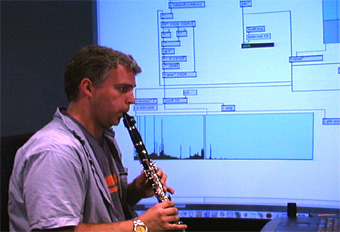 |
|
Multimedia Links:
 David Beaudry Sound Engine - Low
Bandwidth |
Beaudry Sound
Engine - High
Bandwidth
David Beaudry Sound Engine - Low
Bandwidth |
Beaudry Sound
Engine - High
Bandwidth
 David Beaudry Sound Engine - Surestream
David Beaudry Sound Engine - Surestream
 Read David Beaudry's Proposal
Read David Beaudry's Proposal |
|
|
|
|
|
Back to top |
|
|
|
|
|
|
|
|
|
|
|
|
|
|
|
Academic Technology Services, Seeds University Elementary
School, and the UCLA Hammer Museum have finished the successful pilot of a
Visual Thinking Strategies program designed to introduce elementary teachers to
an innovative teaching strategy for young students. The pilot project also
explored a variety of educational and training possibilities offered by UCLA’s
Visualization Portal and Internet2. ATS is currently working with Linda Duke,
director of Education at the UCLA Hammer Museum, on a videotape of the project
that will be shown at the Internet2 Fall conference to be held at USC.
The Visual Thinking Strategy – developed by Psychologist
Abigail Housen and art educator Philip Yenawine - focuses on helping young
students learn to appreciate the arts and apply critical thinking skills learned
in art appreciation to other fields.
The project had three primary objectives – to develop a
model for VTS training that employs Internet2 and can be scaled up for use in
public schools, to expose pre-service teachers – through videoconferenced
participation – to a model of rich, probing discussion among colleagues about
their teaching, and to experiment using the VTS to prepare students to actively
engage with on-screen images that might be used in later distance-learning
initiatives.
“Organizers of this pilot believe there is strong evidence
to indicate that the skills and behaviors fostered in students by the VTS are
exactly those needed for a satisfying educational experience with other
computer-based instructional programs,” said Ms. Duke.
The VTS uses facilitated peer discussion of art images to
help students develop critical and creative thinking, evidence-based reasoning,
advanced looking, and communication skills.
“This is such a rich curriculum,” said Sharon Sutton,
coordinator of Technology and Outreach at Seeds UES. “The benefits for the
students and the teachers are just tremendous.” Ms. Sutton worked with Ms. Duke
to create the program at UES.
Nine UES teachers completed the training, along with
several UCLA graduate students and Los Angeles Unified School District staff
members. ATS videoconferenced the teacher training and debriefing sessions from
UES to the Visualization Portal and to the Massachusetts Institute of Technology
over Internet2.
|
|
|
|
|
|
|
|
Back to top |
|
|
|
|
|
|
|
|
|
|
|
|
|
|
|
UCLA’s new Statistical Computing Web Portal - located at
http://statcomp.ats.ucla.edu - offers visitors an easy way to learn more
about commonly used statistics packages at the same time it provides an
opportunity for people who are interested in statistical computing to interact
with each other. One of UCLA’s Centers for Scholarly Interaction, the
UCLA Stat Computing Portal is a virtual meeting place for the UCLA research and
teaching community and for collaboration among statistical consulting centers
located around the world. See:
http://statcomp.ats.ucla.edu/propcollaboration.htm
The Stat Computing Portal, which provides links to web
sites for commonly used statistical packages such as SAS, Stata, and SPSS, can
also search across those sites to save users the time and effort of searching
each page individually.
The Stat Computing Portal augments the ATS Statistical
computing pages located at
/stat/ and other Statistical Consulting services (/stat/Qtr_Schedule.htm).
For more information about Centers for Scholarly
Interaction, go to:
www.itpb.ucla.edu and click on Strategic Plan Areas of Emphasis.
Back to top |
|
Multimedia Links:
|
|
|
|
|
|